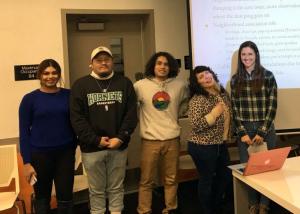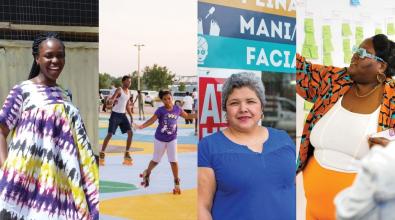Explainer: Why innovative cities are adapting time-tested research methods

In order to solve tough city problems like homelessness or blight, you need to know what’s causing them.
That sounds obvious.
Yet all too often, cities launch programs based more on hunches and assumptions than research and evidence. What’s more, really understanding not just a problem’s symptoms but its root causes requires a more in-depth kind of research than most policymakers are accustomed to.
That’s starting to change. A growing number of cities, including many with innovation teams launched with support from Bloomberg Philanthropies, are stepping up their research game by borrowing techniques from the field of anthropology. In particular, they’re taking the practice of ethnographic research — think of a scientist spending years in the Amazon observing indigenous culture — and adapting it to generate fresh insights about city problems. It’s a critical component in human-centered design, a process a growing number of cities are using to develop innovative solutions.
In our latest explainer, we explore what this style of research is all about and why city leaders should become familiar with it.
What is ethnographic research?
Ethnographic research is an immersive practice aimed at understanding people or a culture by interviewing and observing them in their own environment. Many people adapting these methods in local government prefer other terms, such as qualitative research, or, simply, in-depth research. Whatever you call it, the point for city leaders is the same: to identify people impacted by a problem or situation and develop a deep understanding of how they experience it.
In practice, this means conducting lengthy interviews with a diverse group of people, often in their homes or workplaces. For example, city leaders who are tackling an affordable housing shortage would interview a range of people in different life circumstances: a single mom, a two-parent household, someone with no kids, a person with disabilities, and more. They also would interview local officials who administer rent-assistance programs, landlords, and others with relevant perspectives.
Observation is critical: Researchers might shadow renters as they file applications for apartments or follow them through the process of fighting off an eviction. They might even immerse themselves in those processes directly to uncover additional insights and opportunities.
The goal of all this is to build empathy, said Stephanie Wade, lead for innovation programs at Bloomberg Philanthropies. “If residents are experiencing a problem, we want to understand the problem from their vantage point,” she said. “We want to understand how they think about it, but more importantly, how they feel about it and how it’s impacting their life.”
Why do cities need to do this?
Doing this kind of in-depth research enables innovation to flourish. That’s because it can take a problem policy experts think they already know by heart and flip it upside down. Insights and potential solutions that were hidden before suddenly come into view.
That’s exactly what happened with the Durham, N.C., innovation team’s most successful project yet. The team was working on a tough problem: helping residents returning from prison find jobs or go back to school. One initiative they went on to launch is now helping thousands of people clear old criminal records so they can reclaim driver’s licenses that have been suspended or revoked.
“We never would have gotten to that program had we not been sitting down and talking to people,” said Erin Parish, a design strategist with the Durham i-team. Seemingly everyone Parish and her colleagues interviewed — a woman on probation, the city’s human resources director, a case worker who places people out of prison with jobs, and others — said the same thing: Not having a driver’s license is a major hurdle to getting hired.
“Our task was improving economic opportunities for justice-involved residents,” Parish said. “The straightest line from A to B is a jobs program — not driver’s license restoration. The only way we could get to that idea was by having conversations with people.”
That sort of revelation is something anthropology professor Karen Quintiliani can identify with. Quintiliani teaches at the California State University, Long Beach and has teamed up with that city’s innovation team on a number of projects. “In cities, we often know what a problem is but we don’t always know why it’s happening,” Quintiliani said. “With ethnographic research, you get at the why.”
[Read: In Long Beach, a business model to keep innovation cooking]
City leaders talk with residents all the time. How is this different?
Cities use a lot of tools to listen to residents, from surveys to focus groups to town hall meetings. There’s a place for all of those strategies, but they tend to fall short when it comes to uncovering breakthrough ideas.
“Surveys only get to surface-level data, and focus groups tend to be dominated by certain personalities in the room,” Wade said. “They don’t get into deep aspects of peoples’ feelings and behavior — and what someone actually does in a certain situation, versus what they say they do.”
Ethnographic interviews typically run 90 minutes or more and take place in the subject’s home, workplace, or other relevant setting. Interviewers work hard to build trust with their subjects so that they open up and speak from an emotional space. Questions are open-ended and drive toward understanding the person’s experience of a problem and how it makes them feel. Sometimes, interviewees are asked to draw pictures to tell their story, or talk about a physical object that’s meaningful to them. Observation is critical — researchers don’t just listen to what people say but also watch for what they do.
“We’re trying to get a really deep understanding, not only of peoples’ behaviors but the emotions, motivations, and worldviews that inform their actions and behaviors,” said Ruben Ocampo, a design consultant who has coached a number of cities on using these techniques. “If you just do an intercept interview on the street and grab someone for five minutes, you’ll only get so far. You won’t be able to dig into the why behind what they tell you.”
This way of talking with residents is the polar opposite of how cities engage at town hall meetings. It happens early in the citizen engagement process and is aimed at deepening the understanding of a problem so that city leaders can later work toward smarter solutions. By contrast, town hall meetings are often attended by the same groups of people and are built around already-baked ideas and getting reactions after the fact. Residents often get angry that they weren’t involved sooner.
“When we’ve worked with people in city halls on conducting these in-depth research interviews they say, ‘This is great — I get to have proactive conversations with residents and make them part of defining the problem early on,’” Ocampo said. “They’re no longer selling residents on something and getting attacked for it.”
Who in the city should conduct this research?
Some cities have begun hiring professional anthropologists to do this work. Erin Parish of Durham’s i-team is a trained anthropologist. The Long Beach i-team partners with Professor Quintiliani to bring anthropology students onto projects. Many more cities have begun hiring trained designers, who typically have a foundation in these research methods.
You don’t have to have a Ph.D. in anthropology to do ethnographic research, said Parish, who has one. But it does require training in some specialized interview techniques, as well as how to capture data from those interviews in a way that can be useful to policymakers. There’s an art and a science to this, and it can do more harm than good to just throw people out in the field without training or supervision from a pro.
Parish is keen on teaming up with people who have lived experience with the problem she’s researching. For the project exploring how to help residents returning from prison, she trained her i-team colleague, Chuck Manning, who had been in and out of prison several times earlier in his life. Manning’s presence was critical to building rapport with residents they interviewed in jail. “The things people will say to Chuck are completely different than the things they’ll say to me,” Parish said. “We need to be aware of the limits of our own knowledge and what we think immersion is.”
[Read: To fix the road back from prison, Durham turns to a guide who knows it well]
Typically, two people are present to conduct interviews — one to lead the discussion and the other to take notes. Wade encourages cities she works with to take senior leaders and even the mayor out in the field to observe these interviews. “It’s almost like the TV show ‘Undercover Boss,’” she said. “They should not lead the interview, just listen and learn. They’ll become the biggest advocates for this work once they see things that they can’t see from their desks at City Hall.”
Who do we need to be interviewing?
Typically, cities using these methods will start by mapping all the stakeholders who intersect with the problem they’re working on. If the aim were to improve access to early childhood education, they’d want to interview a variety of parents from different income levels: single moms, two-head households, people who work multiple jobs, or don’t own cars. They’d interview people who run pre-k programs in schools or church basements, and childcare centers in homes or office buildings. They’d interview admissions officers and teachers, school administrators and employers. They’d tackle it from every angle.
“You want to break down these different demographics to understand different aspects of the problem,” Wade said. “It’s complicated. No one person or one experience will tell you what the root cause of the problem is. So you need to triangulate it by talking to multiple people from different groups. Most of these stakeholders are outside of city hall but some are internal. You want to be talking to senior officials who are setting policy, mid-level managers who are operating programs, and especially the frontline folks who are out in the community seeing this challenge first-hand.”
Tapping into a diversity of experiences is critical, Wade said. You don’t just want to find people who represent the average or typical experience, but also outliers. If you’re working on preventing evictions, for example, it would be useful to hear from someone who’s been evicted five times or more. “When we design for extreme cases,” she said, “we often come up with more creative solutions that serve a greater number of people than if we only design for people with more average experiences.”
Deciding how many people to interview can be challenging. While a typical city project might involve 50 or more interviews, you don’t want to talk to so many people that you get overloaded with data. (One rule of thumb: You can stop interviewing certain groups of people when you start hearing similar things from them.)
It also can be a challenge finding the right people to interview. Ocampo worked on a project in Helsinki, where the city’s goal was to help aging seniors stay active.
“We needed to reach people who aren’t leaving home, and to understand what was preventing them from going out,” Ocampo said. “You can’t intercept them on the street. It was a challenge finding them, and getting to talk to them inside their home, but it was so important. Because when they’d tell us things like, ‘I can’t leave home because there’s a physical barrier in the way,’ they could show us the steps or whatever it was. And by seeing it first-hand we could understand it better.”
What do you do with these research findings?
For cities that are using a human-centered design process to solve problems, this research comes at an early stage. The next step is to unpack everything researchers heard and observed and to look for patterns, which can be used to generate insights about what’s really causing problems residents are experiencing. Those insights lead to ideas that can be prototyped and tested with residents and eventually launched as pilot programs.
[Read our explainer on human-centered design]
A critical piece is marrying all the qualitative data from interviews with quantitative data. After interviews in Durham kept turning up the difficulty of finding a job without a driver’s license, the team did some digging. They found from the state Department of Transportation that nearly 50,000 residents in their county had their driver’s licenses revoked. They knew they were onto something big.
“You want to find quantitative data that backs up or expands on what you’re finding,” Parish said. “As a qualitative researcher, I wish the qualitative research was enough. But often, people find it to be anecdotal. When you start getting into policy, you want these methods working together.”
Sometimes, ethnographic research leads city teams to an unexpected realization: that the problem that actually needs solving is not what they thought it was at first. While that can be frustrating, it’s better to know that early — when there’s time to pivot to a new approach.
“By slowing down in the beginning of a project and taking the time to talk to residents in-depth, cities can save time and money,” Wade said. “That’s because they’re understanding the root cause of a problem, and making sure the investments they make with taxpayer dollars are the right ones.”
Read more explainers from Bloomberg Cities:




